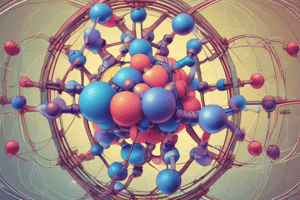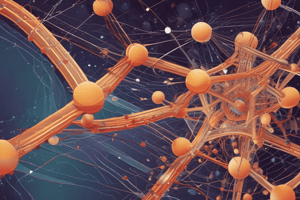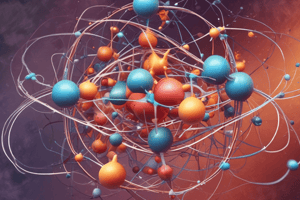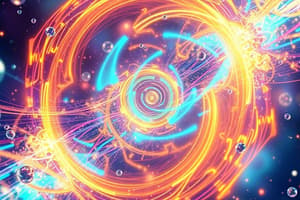Podcast
Questions and Answers
Which of the following is a physical property?
Which of the following is a physical property?
- Flammability
- Corrosiveness
- Rusting
- Ductility (correct)
Molecules are made of two or more atoms bonded together.
Molecules are made of two or more atoms bonded together.
True (A)
What determines whether an object will float or sink in a liquid?
What determines whether an object will float or sink in a liquid?
Density
The ability to dissolve in another substance is known as __________.
The ability to dissolve in another substance is known as __________.
Match the following terms with their definitions:
Match the following terms with their definitions:
Which of the following represents a chemical change?
Which of the following represents a chemical change?
Homogeneous mixtures have a non-uniform composition.
Homogeneous mixtures have a non-uniform composition.
What is the smallest unit of an element?
What is the smallest unit of an element?
Which of the following models describes electrons existing in probability clouds around the nucleus?
Which of the following models describes electrons existing in probability clouds around the nucleus?
The Law of Conservation of Matter states that matter can be created or destroyed.
The Law of Conservation of Matter states that matter can be created or destroyed.
What is the formula for calculating density?
What is the formula for calculating density?
In a chemical reaction, the total mass of __________ remains constant.
In a chemical reaction, the total mass of __________ remains constant.
What type of interaction is characterized by sharing electron pairs between atoms?
What type of interaction is characterized by sharing electron pairs between atoms?
Which of the following is NOT considered matter?
Which of the following is NOT considered matter?
Match the following parts of the Ideal Gas Law with their meanings:
Match the following parts of the Ideal Gas Law with their meanings:
All states of matter have a definite shape and volume.
All states of matter have a definite shape and volume.
Energy transformations only occur during chemical reactions.
Energy transformations only occur during chemical reactions.
What are the two main characteristics of particles in a solid?
What are the two main characteristics of particles in a solid?
Identify one type of intermolecular force.
Identify one type of intermolecular force.
The phase change from solid to liquid is known as __________.
The phase change from solid to liquid is known as __________.
Match the phases of matter with their particle arrangements:
Match the phases of matter with their particle arrangements:
What does the Kinetic Molecular Theory state about the particles in matter?
What does the Kinetic Molecular Theory state about the particles in matter?
The triple point refers to the condition where solid, liquid, and gas coexist.
The triple point refers to the condition where solid, liquid, and gas coexist.
When heat is added to ice, it undergoes __________ to become water.
When heat is added to ice, it undergoes __________ to become water.
Flashcards
Matter definition
Matter definition
Anything that has mass and takes up space.
Solid state
Solid state
Has a fixed shape and volume; particles are tightly packed.
Liquid state
Liquid state
Has a fixed volume, but takes the shape of its container. Particles move past each other.
Gas state
Gas state
Signup and view all the flashcards
Plasma state
Plasma state
Signup and view all the flashcards
Kinetic Molecular Theory
Kinetic Molecular Theory
Signup and view all the flashcards
Phase changes
Phase changes
Signup and view all the flashcards
Triple point
Triple point
Signup and view all the flashcards
Ductility
Ductility
Signup and view all the flashcards
Malleability
Malleability
Signup and view all the flashcards
Solubility
Solubility
Signup and view all the flashcards
Density
Density
Signup and view all the flashcards
Flammability
Flammability
Signup and view all the flashcards
Element
Element
Signup and view all the flashcards
Compound
Compound
Signup and view all the flashcards
Homogeneous Mixture
Homogeneous Mixture
Signup and view all the flashcards
What is the Law of Conservation of Matter?
What is the Law of Conservation of Matter?
Signup and view all the flashcards
Bohr Model
Bohr Model
Signup and view all the flashcards
Quantum Model
Quantum Model
Signup and view all the flashcards
Chemical Reaction
Chemical Reaction
Signup and view all the flashcards
Energy and Matter
Energy and Matter
Signup and view all the flashcards
Intermolecular Forces
Intermolecular Forces
Signup and view all the flashcards
Density Calculation
Density Calculation
Signup and view all the flashcards
Ideal Gas Law
Ideal Gas Law
Signup and view all the flashcards
Study Notes
Matter and Its Properties
- Matter: Anything that has mass and occupies space. Examples include rocks, air, water, and the human body. Light and sound are not matter.
States of Matter
-
Solids: Have a definite shape and volume. Particles are closely packed and vibrate in place. Examples include ice and wood.
-
Liquids: Have a definite volume but take the shape of their container. Particles are close together but can move past one another. Examples include water and oil.
-
Gases: Have no definite shape or volume; they expand to fill their container. Particles are far apart and move freely. Examples include oxygen and carbon dioxide.
-
Plasma: A highly energized, ionized gas with free electrons. Found in stars, lightning, and neon signs. Less common than other states of matter.
Kinetic Molecular Theory
- Assumptions: All matter consists of tiny particles, particles are in constant motion, particles collide with each other and container walls, collisions are perfectly elastic (no energy loss).
Properties of Matter
-
Physical Properties: Observed without changing the substance's identity. Examples include color, odor, density, melting point, boiling point, ductility (ability to be drawn into wire), malleability (ability to be shaped), solubility (ability to dissolve in another substance), density (mass per unit volume), and luster (surface shine). Also includes conductivity (ability to transmit electrical charge) and magnetism (response to magnetic fields).
-
Chemical Properties: Describe a substance's ability to change into a new substance. Examples are flammability, reactivity with other substances, oxidation, pH, corrosiveness.
Classification of Matter
-
Pure Substances: Consist of a single type of atom or molecule. Examples include elements (like neon) and compounds (like water).
-
Mixtures: Two or more pure substances combined without chemically bonding. Homogeneous mixtures have a uniform composition (like air), while heterogeneous mixtures do not (like salad).
Building Blocks of Matter
-
Atoms: The smallest unit of an element. Composed of protons, neutrons, and electrons. Example: A gold atom retains the properties of gold.
-
Molecules: Two or more atoms bonded together (e.g., H₂O).
Measuring Matter
-
Mass: Amount of matter in an object, measured using grams or kilograms.
-
Volume: Amount of space an object occupies, measured using liters, milliliters, or cubic centimeters.
-
Density: Mass per unit volume (mass divided by volume). Used to determine if objects will float or sink in liquids.
Changes in Matter
-
Physical Changes: Alter physical properties without changing the substance's identity. Examples include melting, freezing, dissolving.
-
Chemical Changes: Form new substances by changing the substance's identity. Examples include rusting or burning.
Conservation of Matter
- Matter is neither created nor destroyed in chemical reactions; only changes form.
Advanced Concepts
-
Atomic Models: Different models describing the atom's structure (e.g., Bohr model, quantum model).
-
Chemical Reactions: Processes where reactants transform into new products, often with energy exchange.
-
Energy and Matter: Matter can transform between potential and kinetic energy. Transformations often occur during phase changes (changes in state) and chemical reactions.
-
Intermolecular Forces: Forces between molecules, such as Van der Waals forces, hydrogen bonding, ionic, and covalent interactions.
Key Formulas
-
Density: Density = Mass/Volume
-
Ideal Gas Law: PV=nRT ( Pressure × Volume = number of moles × Ideal gas constant × Temperature)
Studying That Suits You
Use AI to generate personalized quizzes and flashcards to suit your learning preferences.




